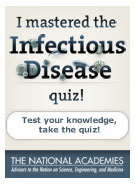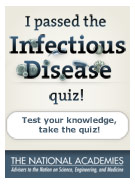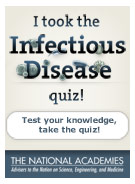
What You Need To Know About Infectious Disease
What do you know about infectious disease?
Which of the following diseases is NOT caused by a virus?
-
Sorry, that’s incorrect.
Tuberculosis is caused by a bacterial infection. Chicken pox, the common cold, and influenza are all caused by viral infections.
-
Sorry, that’s incorrect.
Tuberculosis is caused by a bacterial infection. Chicken pox, the common cold, and influenza are all caused by viral infections.
-
Sorry, that’s incorrect.
Tuberculosis is caused by a bacterial infection. Chicken pox, the common cold, and influenza are all caused by viral infections.
-
Correct!
Tuberculosis is caused by a bacterial infection. Chicken pox, the common cold, and influenza are all caused by viral infections.
How many people in the world do not have access to an adequate water supply?
-
Sorry, that’s incorrect.
Worldwide, 884 million people do not have access to an adequate water supply, and about three times that number lack basic sanitation services. An estimated 2 million deaths a year can be attributed to unsafe water supplies.
-
Sorry, that’s incorrect.
Worldwide, 884 million people do not have access to an adequate water supply, and about three times that number lack basic sanitation services. An estimated 2 million deaths a year can be attributed to unsafe water supplies.
-
Correct!
Worldwide, 884 million people do not have access to an adequate water supply, and about three times that number lack basic sanitation services. An estimated 2 million deaths a year can be attributed to unsafe water supplies.
The 1918 influenza pandemic (the so-called “Spanish” flu) is estimated to have killed how many people worldwide?
-
Sorry, that’s incorrect.
The 1918 influenza pandemic is estimated to have killed between 50 million and 100 million people worldwide. Many of those deaths were due to the effects of pneumococcal pneumonia, a secondary complication of flu for which no antibiotics existed in 1918.
-
Sorry, that’s incorrect.
The 1918 influenza pandemic is estimated to have killed between 50 million and 100 million people worldwide. Many of those deaths were due to the effects of pneumococcal pneumonia, a secondary complication of flu for which no antibiotics existed in 1918.
-
Correct!
The 1918 influenza pandemic is estimated to have killed between 50 million and 100 million people worldwide. Many of those deaths were due to the effects of pneumococcal pneumonia, a secondary complication of flu for which no antibiotics existed in 1918.
Which of these viral diseases has the most antiviral drugs available to treat it?
-
Sorry, that’s incorrect.
Today there are more antiviral drugs available for HIV than for any other viral disease, transforming an infection that was once considered a death sentence into a manageable chronic condition.
-
Correct!
Today there are more antiviral drugs available for HIV than for any other viral disease, transforming an infection that was once considered a death sentence into a manageable chronic condition.
-
Sorry, that’s incorrect.
Today there are more antiviral drugs available for HIV than for any other viral disease, transforming an infection that was once considered a death sentence into a manageable chronic condition.
-
Sorry, that’s incorrect.
Today there are more antiviral drugs available for HIV than for any other viral disease, transforming an infection that was once considered a death sentence into a manageable chronic condition.
For which of the following diseases do we currently lack an effective vaccine for prevention?
-
Sorry, that’s incorrect.
Although there are treatments available in the form of antivirals, we still currently lack a vaccine for HIV.
-
Sorry, that’s incorrect.
Although there are treatments available in the form of antivirals, we still currently lack a vaccine for HIV.
-
Correct!
Although there are treatments available in the form of antivirals, we still currently lack a vaccine for HIV.
-
Sorry, that’s incorrect.
Although there are treatments available in the form of antivirals, we still currently lack a vaccine for HIV.
If you have strep throat, which of the following forms of medication can be used to effectively treat the infection?
-
Sorry, that’s incorrect.
Because strep throat is caused by a bacterium called Streptococcus pyogenes, it is treatable with antibiotics but not antivirals. Currently there is no vaccine available to prevent strep throat.
-
Correct!
Because strep throat is caused by a bacterium called Streptococcus pyogenes, it is treatable with antibiotics but not antivirals. Currently there is no vaccine available to prevent strep throat.
-
Sorry, that’s incorrect.
Because strep throat is caused by a bacterium called Streptococcus pyogenes, it is treatable with antibiotics but not antivirals. Currently there is no vaccine available to prevent strep throat.
-
Sorry, that’s incorrect.
Because strep throat is caused by a bacterium called Streptococcus pyogenes, it is treatable with antibiotics but not antivirals. Currently there is no vaccine available to prevent strep throat.
In 2008, about how many people worldwide were infected with HIV (human immunodeficiency virus)?
-
Sorry, that’s incorrect.
In 2008, more than 33 million people worldwide were infected with HIV (human immunodeficiency virus). In that same year, an estimated 2 million people died from AIDS (acquired immunodeficiency syndrome), the final stage of HIV infection.
-
Sorry, that’s incorrect.
In 2008, more than 33 million people worldwide were infected with HIV (human immunodeficiency virus). In that same year, an estimated 2 million people died from AIDS (acquired immunodeficiency syndrome), the final stage of HIV infection.
-
Correct!
In 2008, more than 33 million people worldwide were infected with HIV (human immunodeficiency virus). In that same year, an estimated 2 million people died from AIDS (acquired immunodeficiency syndrome), the final stage of HIV infection.
True or False: Infection with a pathogen (a disease-causing microbe) does not necessarily lead to disease.
-
Correct!
Infection occurs when viruses, bacteria, or other microbes enter your body and begin to multiply. Disease follows when the cells in your body are damaged as a result of infection, and signs and symptoms of an illness appear.
-
Sorry, that’s incorrect.
Infection occurs when viruses, bacteria, or other microbes enter your body and begin to multiply. Disease follows when the cells in your body are damaged as a result of infection, and signs and symptoms of an illness appear.
How many people in the United States die from flu-related complications each year?
-
Sorry, that’s incorrect.
About 36,000 people die from flu-related complications each year in the United States. More than 200,000 are hospitalized.
-
Correct!
About 36,000 people die from flu-related complications each year in the United States. More than 200,000 are hospitalized.
-
Sorry, that’s incorrect.
About 36,000 people die from flu-related complications each year in the United States. More than 200,000 are hospitalized.
Thank you for taking our quiz.
Place this badge on your Facebook page to show your friends what you know about infectious disease.
Place this badge on your Facebook page to show your friends what you know about infectious disease.
OR, get a higher score to unlock a different badge.
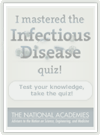
Place this badge on your Facebook page to show your friends what you know about infectious disease.
OR, get a higher score to unlock a different badge.
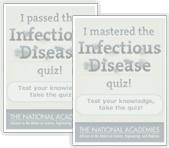
Explore Other Topics
Disease Watchlist
Infectious Disease Defined
- Mortality
The number of deaths in a given time or place.
